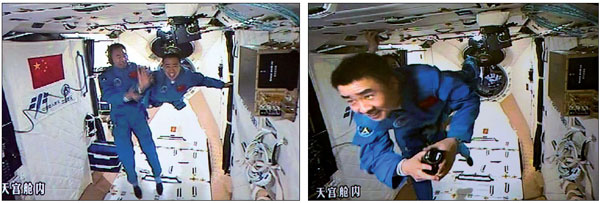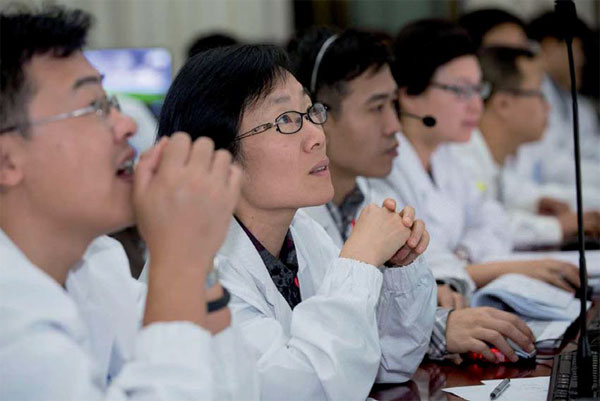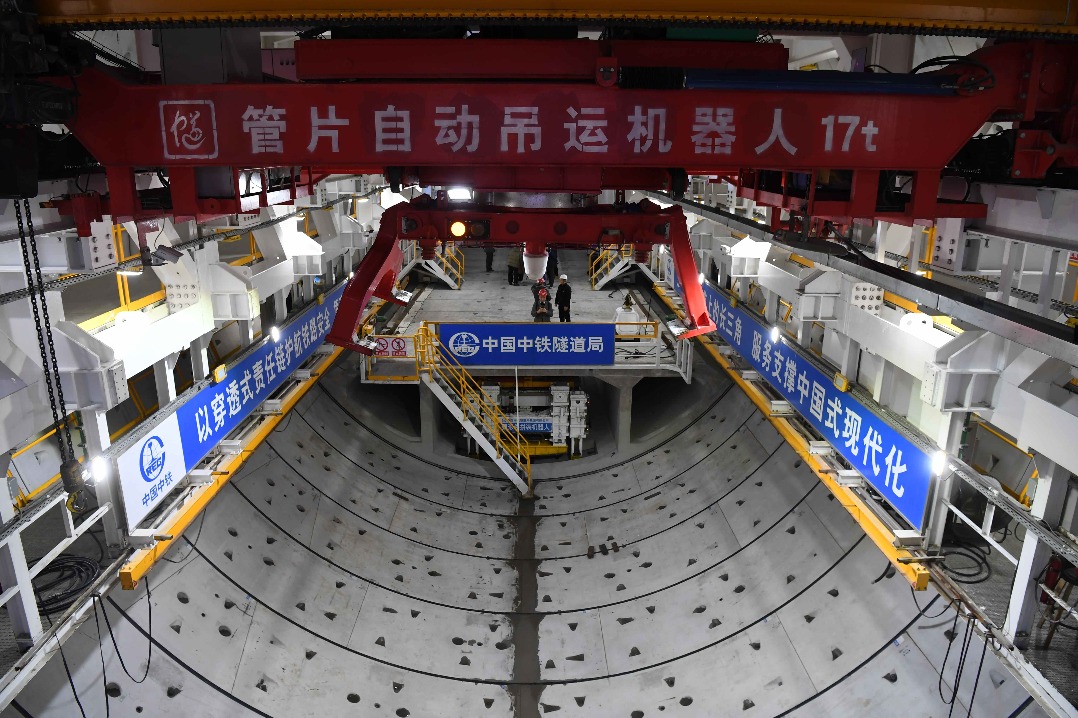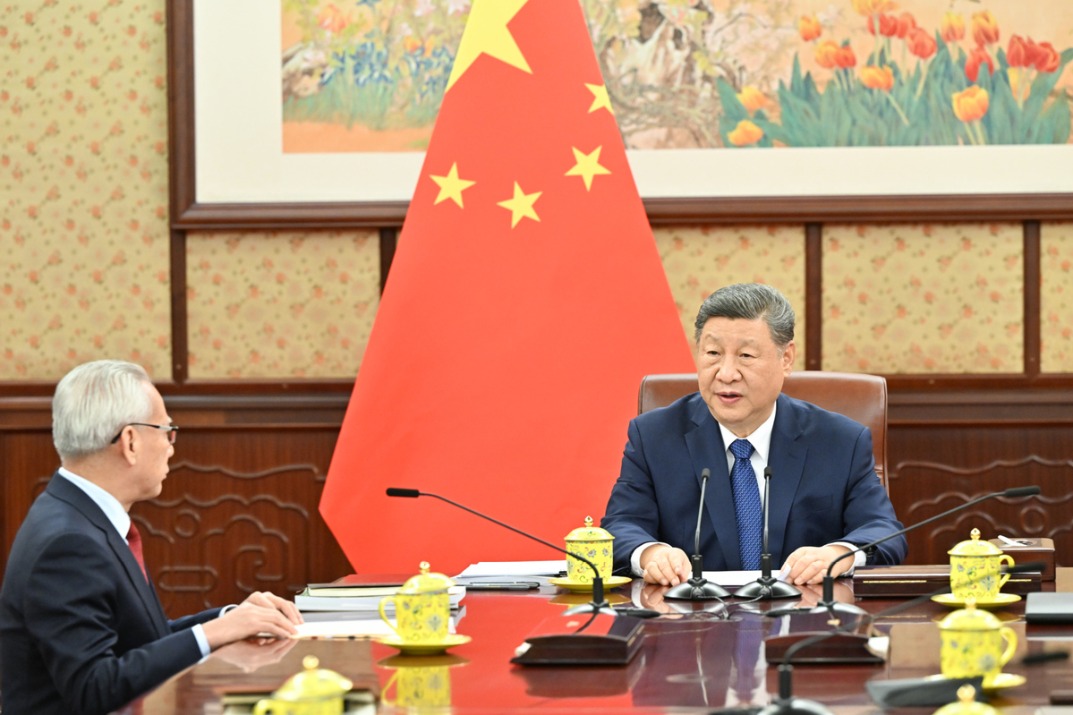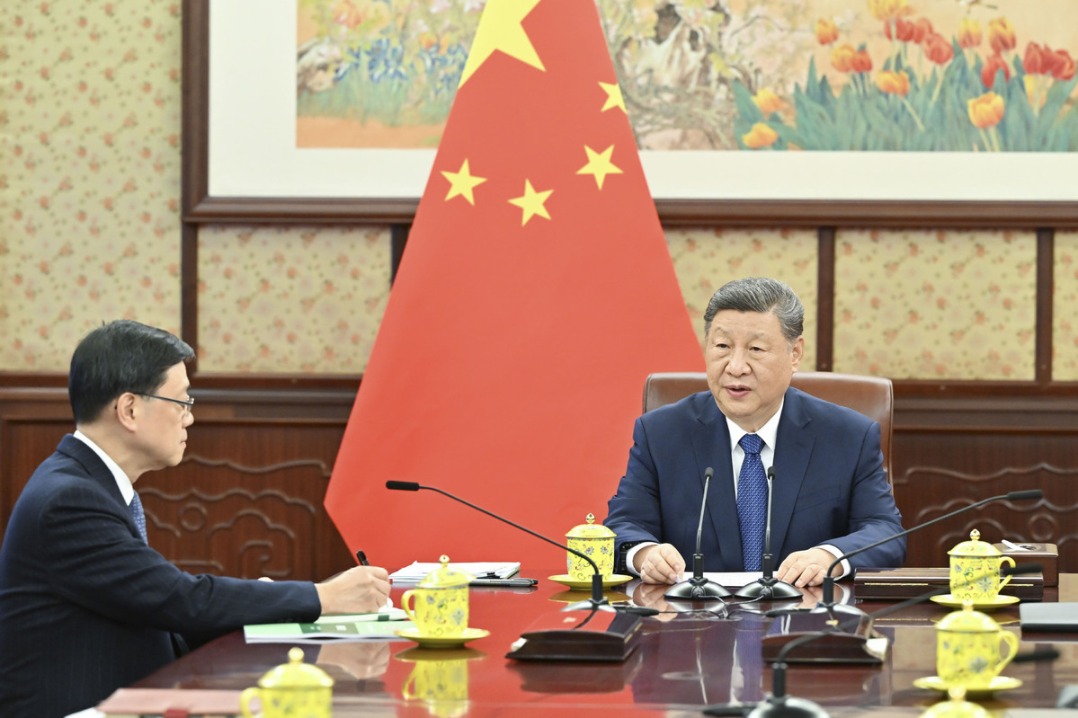In space lab, there's no shortage of work

Two astronauts push country's aspirations forward as they begin the longest Chinese stay in orbit so far
The two Chinese astronauts who rocketed into orbit aboard the Shenzhou XI spacecraft have begun their monthlong stay in the Tiangong II space lab, with a tight schedule for accomplishing many tasks.
As the world watched on television, Shenzhou XI, under computer control, docked with Tiangong II early on Oct 19.
After the docking, mission commander Jing Haipeng, 49, and Chen Dong, 37, floated weightlessly into the space lab and extended greetings to the Chinese people from 393 kilometers above the Earth.
| From left: Jing Haipeng, left, and Chen Dong greet viewers shortly after entering the space lab on Oct 19; Chen Dong floats in the space lab. Photos by Ju Zhenhua / Xinhua |
| Scientists fix their gaze on monitors at Beijing Aerospace Control Center as Shenzhou XI prepares to dock with the Tiangong II space lab on Oct 19. Ju Zhenhua / Xinhua |
They intend to remain in the space lab for 30 days, the longest space stay to date by Chinese astronauts. Before this mission, the longest Chinese space journey was the 15-day Shenzhou X mission in June 2013.
Jing is an experienced space traveler. He was a member of the Shenzhou VII mission in 2008 and the Shenzhou IX mission in 2012.
Chen is the first man in the second generation of Chinese astronauts to make a spaceflight. Two of his female counterparts in that group, Liu Yang and Wang Yaping, have been in space, in the process gaining fame and hero status.
Both Jing and Chen are able to pilot the spacecraft, execute the docking procedure, manage the spacecraft-space lab combination and handle possible emergencies, according to Wu Ping, deputy director and spokeswoman for the China Manned Space Agency.
"They will work eight hours each day and six days each week," Wu says. "We prepared more than 100 kinds of foods and beverages for them in space. They can use the treadmill and exercise bike in Tiangong II and can communicate with their family via video, audio and email," Wu says.
Huang Weifen, deputy research head of the Astronaut Center of China, says that compared with previous journeys of Chinese astronauts, the Shenzhou XI-Tiangong II mission will be the busiest. Scientists have planned more than 40 experiments and other tasks.
The two astronauts will verify the life-support capability of the spacecraft-space lab combination and conduct many scientific research and engineering experiments.
Among other things, they will sprout seeds and study their growth in space; and they will take part in an experiment in which a futuristic device will try to translate their brain impulses into words to communicate with ground controllers and to activate instruments in the spacecraft.
In addition, a remote medical support system - the first of its kind in China - will get a trial run during the mission.
However, before the astronauts can carry out their tasks, they must overcome a host of difficulties, experts say.
"No matter how realistic the ground training is, it's difficult to simulate the true state of weightlessness in space," says Wang Ya'nan, editor-in-chief of Aerospace Knowledge magazine. "Astronauts experience a certain period of fullness in the head after the spacecraft enters orbit. They must get used to the weightlessness as soon as possible."
Qu Lina, a senior space medicine researcher at the astronaut center, says the astronauts must prevent cardiovascular disorders and muscle atrophy that often plague space travelers.
Designers say that to provide astronauts a comfortable environment, sound-dampening devices were installed in Tiangong II to ensure that noise is held under 50 decibels. A heat control instrument is supposed to keep the temperature inside the spacecraft between 22 C and 24 C, and humidity between 45 and 55 percent.
Shenzhou XI blasted off atop a Long March 2F rocket on Oct 17 from the Jiuquan Satellite Launch Center in northwestern China, about one month after the launch of Tiangong II in mid-September.
With a height of 10.4 meters and a weight of 8.6 metric tons, the Tiangong II comprises two cabins with separate functions - an experiment cabin, which is hermetically sealed and acts as the astronauts' living quarters, and the resource cabin, which contains solar panels, storage batteries, propellant and engines. The craft was designed to operate for two years in space.
China launched its first space lab, Tiangong I, in September 2011. Although it had a design lifespan of two years, it stayed in service for four and a half years. It conducted six automatic and astronaut-controlled docking maneuvers with the Shenzhou VIII, Shenzhou IX and Shenzhou X spacecraft.
The Shenzhou XI-Tiangong II mission is China's sixth manned spaceflight and is expected to pave the way for a permanent space station, which the space authority plans to start building in 2018 and put into service around 2022.
Since 2003, and before Shenzhou XI, the nation had sent five spacecraft and 10 astronauts into space. The first was Shenzhou V, which carried the nation's first astronaut Yang Liwei, now a senior space official.
China is the third country in the world that has independently developed manned spaceflight, following the lead of the former Soviet Union and the United States.
Inspired by grand space aspirations, China has begun designing a superheavy rocket that will have a takeoff weight of 3,000 tons and will be able to thrust a 100-ton payload into low Earth orbit - seven times powerful than the Long March 7, the strongest in China's current rocket family - according to executives from China Aerospace Science and Technology Corp, the major contractor for the nation's space activities.
The mega rocket will be a key part of a manned lunar mission, which will take 15 to 20 years for China to realize, according to and April statement by Lieutenant General Zhang Yulin, deputy head of the Central Military Commission's Equipment Development Department.
zhaolei@chinadaily.com.cn
(China Daily Africa Weekly 10/21/2016 page14)
Today's Top News
- Crossing a milestone in the journey called Sinology
- Chinese, Russian media outlets urged to enhance cooperation
- Where mobility will drive China and the West
- HK community strongly supports Lai's conviction
- Japan paying high price for PM's rhetoric
- Japan's move to mislead public firmly opposed
















